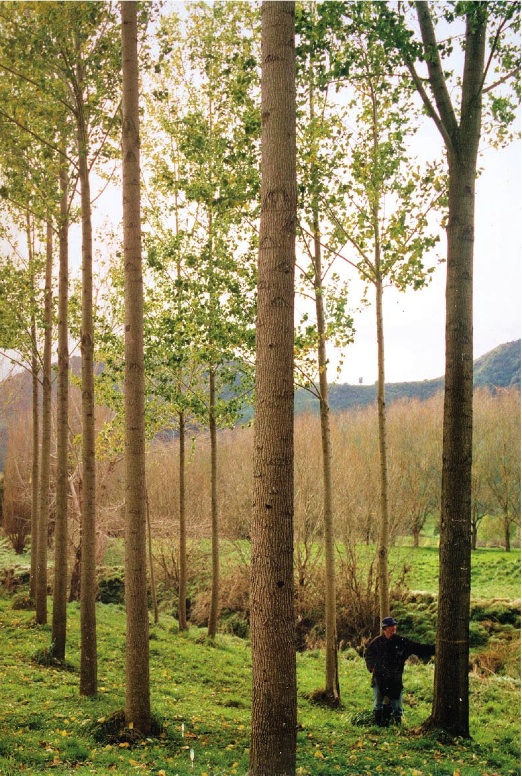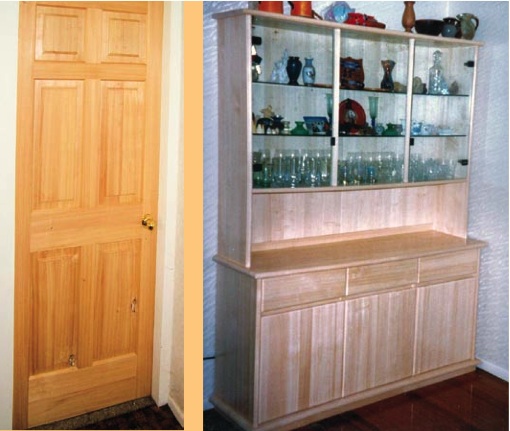Growing poplars for timber in Northland
Murray Hunter and Ian McIvor, New Zealand Tree Grower May 2008.
Internationally poplar is an important timber tree providing a range of end uses either as timber, chip or pulp. Good quality butts provide excellent rotary peeling for veneers and can be sawn easily producing a light, good quality timber. Uses for the timber include cabinet making and musical instruments, and for rough wood, pallets and boxes.
Poplar timber is favoured by architects because its light colour allows a wide choice of stains, in addition to its lightness and strength. Thinnings or top and lop can be used for chipboard, fibreboard and pulp. Being light and odour free, it has real advantages over softwoods since it does not require prior treatment. Current export markets for New Zealand poplar logs are largely centred on China.
Ideal plantation trees
Poplars are ideal plantation trees because of their very fast growth. Deep planting, if necessary down to 60 cm, is essential to ensure that rooting develops in permanently moist soil. Single line planting of poplars provide useful wind breaks, but wider shelter belts, from three to six rows wide, will provide much improved shelter from wind, and can encourage woodland conditions to develop.
As one of the authors of this article, Murray Hunter is highly motivated in seeing a poplar crop mature to harvestable size, milling it to order and promoting the wood for a range of uses. Murray was the first in the country to mill the kawa hybrid, when in 1998 he milled a tree planted in 1983. The tree had reached 25 metres in height, with a diameter at breast height of 400 mm and with eight metres of butt log. After drying, the timber was processed professionally and used to manufacture two panelled doors and a dresser unit.
The HortResearch-developed Populus yunnanensis × P. deltoides hybrid kawa is the most favoured poplar clone in the north. It is fast growing with strong apical dominance, good resistance to the main diseases and a low palatability to possums.
Selection and establishment of material

The planting season is from June through to September and a moist, fertile site is recommended for best results and optimum growth rates, although poplars will survive in less favourable areas.
Stakes of 1.5 metres to 2 metres are suitable for most applications. Three metre poles are needed, preferably with protective sleeves, where livestock have access. Forestry wands are only 800 mm long and are suitable for plantation planting on moister sites, where stock is excluded, at 400 stems per hectare.
When planting, all grades should have their bottom ends pointed and driven one-third of their length into a pilot hole to ensure the best survival rate. Competition from weeds and grasses should be eliminated by spraying with a suitable herbicide at planting and then two or three months later, especially with the smaller grades.
Pruning
Stakes and wands should have their first pruning at four to six months, when the strongest shoot is selected and the others removed with sharp secateurs. The main stem should also be cut, about 15 mm above the selected shoot. However, the three metre poles should be left for 16 to 18 months before selecting the main leader to grow on.
To obtain a pruned butt for timber, branches should be removed, beginning at two to four years, to no more than half of the tree height. The first heavy whorl of branches should be removed, along with a few lighter branches. This can be done in late February or March to minimise regrowth from the pruning cuts. The main leader should be inspected for damage and re-selected if necessary. The trees should have lifts every two or three years until the desired butt length of six to eight metres is reached.
Budgeting
In optimum conditions wands will grow as fast as stakes and poles, and in three years it may not be possible to tell them apart. The choice of planting material will depend on moisture availability during establishment – smaller planting material will experience stress more readily – and how exposed the trees will be to browsing stock, or possums.
You should budget on $10 per planted poplar pole. This includes tree cost, transport, planting and protection. As an indication, Stix Nursery’s 2007 prices were wands $1, stakes $2.80 and poles $3.30 and $4.80. Possum guards which are 600 mm long were $1.30 each with 1.7 metre stock and possum protectors up to $4 each.
By selecting a variety with good form and managing it for timber end use on a 25 to 35 year rotation, you will have trees that will provide shade, shelter, soil stabilising and possibly stock fodder. There will be a return when they are harvested and the problem of old large trees will be avoided.
Murray and Margaret milling and marketing

When government subsidies were removed in the 1980s the Northland Regional Council pulled out of pole planting. To keep the nursery viable we decided to promote poplar as a future timber resource. I purchased a Woodmiser bandsaw mill, and later a dehumidifier kiln and four-sider planer for processing poplar logs.
I had access to some of the old Italian hybrids which were 30 years old, up to a metre in diameter but only pruned as high as a cow could reach. The wood from the butt logs made excellent timber for virtually any purpose, and was used in boat building, joinery manufacturing and panelling.
When milling I have quarter sawn the timber and quarter sawn the log as well, especially smaller trees less than 600mm dbh, to relieve any tension, and used a slow drying regime. I would recommend this procedure to anyone planning to do their own milling or getting some of their trees milled for their own use. Poplar also takes treatments and any finishes well.
Early in 2007 we exported a truck load of 10 year thinnings to China as K grade for use in plywood, for a slightly better price than radiata.

 Farm Forestry New Zealand
Farm Forestry New Zealand